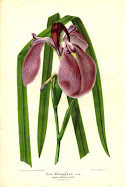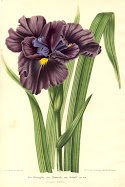How?
Photo 5: In this photo the style is at the top of the style arm with the stigma at centre of the lip. After you have removed the falls and anthers the flower still needs time to mature. This can take from a few hours to the following day for the stigma to mature and open out away from the style in order to be receptive to receiving the pollen.
the flower still needs time to mature. This can take from a few hours to the following day for the stigma to mature and open out away from the style in order to be receptive to receiving the pollen.
I plan it so that I remove the petals from the unopened flower the day before I want to do the cross.Then the next morning once the dew has gone I proceed with my transfer of pollen onto the open stigma which the style arms are more flexible for handling. If you leave the transfer to the afternoon on that second day the style arm have become very stiff and erect or turgid and it is very easy to damage the style arm while making the crosses with my big fingers trying to hold the style arms. More care is needed. I find that if I am not careful I snap the style arm and therefore you only have two stigmas left to transfer pollen to. I have been known to damage two stigmas in trying to do my cross by breaking off the style arms and the third transfer pollinated forming seed in only one cavity of the ovary.
 the flower still needs time to mature. This can take from a few hours to the following day for the stigma to mature and open out away from the style in order to be receptive to receiving the pollen.
the flower still needs time to mature. This can take from a few hours to the following day for the stigma to mature and open out away from the style in order to be receptive to receiving the pollen.I plan it so that I remove the petals from the unopened flower the day before I want to do the cross.Then the next morning once the dew has gone I proceed with my transfer of pollen onto the open stigma which the style arms are more flexible for handling. If you leave the transfer to the afternoon on that second day the style arm have become very stiff and erect or turgid and it is very easy to damage the style arm while making the crosses with my big fingers trying to hold the style arms. More care is needed. I find that if I am not careful I snap the style arm and therefore you only have two stigmas left to transfer pollen to. I have been known to damage two stigmas in trying to do my cross by breaking off the style arms and the third transfer pollinated forming seed in only one cavity of the ovary.
Photo 8: In this photo, it shows the pollen and the receptive open stigma. The process of the transfer of pollen is complete. In the centre of the open lip is the open stigma ready to receive any pollen placed on the lip. Try to gently place heaps of pollen on the stigma for the cross to succeed.
You can use a very soft brush or tooth pick with bruised ends to fray the end, then apply the pollen to this area of the stigma. You can also use your finger as the pollen grains, when dry, will adhere to it or use the open anther and rub it gently downwards over the open lip.
very soft brush or tooth pick with bruised ends to fray the end, then apply the pollen to this area of the stigma. You can also use your finger as the pollen grains, when dry, will adhere to it or use the open anther and rub it gently downwards over the open lip.
Thoroughly clean any brush used between crosses in a alcohol solution and allow to dry completely between any changes in pollen parents.
You can use a
 very soft brush or tooth pick with bruised ends to fray the end, then apply the pollen to this area of the stigma. You can also use your finger as the pollen grains, when dry, will adhere to it or use the open anther and rub it gently downwards over the open lip.
very soft brush or tooth pick with bruised ends to fray the end, then apply the pollen to this area of the stigma. You can also use your finger as the pollen grains, when dry, will adhere to it or use the open anther and rub it gently downwards over the open lip.Thoroughly clean any brush used between crosses in a alcohol solution and allow to dry completely between any changes in pollen parents.
If there is very heavy rain over night, hold over your pollen from the pollen parent and prepare another pod parent flower ready for the following day.
You can place a small plastic cover bag over the 3 style arms overnight to act as an umbrella only to protect them if rain is forecast. Please remove early in the morning before the sun hits the prepared flower to prevent sweating of the flower parts.
Once the transfer of pollen has taken place, your cross is safe after 2 to 3 hours if gentle rain comes in the afternoon. Or if rain is immanent then again place a small plastic bag over the flower style arms will allow time for pollination process to occur. Remove bag after rain passes.
If heavy rain follows without cover there is the likelihood of your cross succeeding being reduce severely or could fail. Then plan to do the cross again a few days later if you have sufficient pollen and pod parent flowers to achieve this.
You can place a small plastic cover bag over the 3 style arms overnight to act as an umbrella only to protect them if rain is forecast. Please remove early in the morning before the sun hits the prepared flower to prevent sweating of the flower parts.
Once the transfer of pollen has taken place, your cross is safe after 2 to 3 hours if gentle rain comes in the afternoon. Or if rain is immanent then again place a small plastic bag over the flower style arms will allow time for pollination process to occur. Remove bag after rain passes.
If heavy rain follows without cover there is the likelihood of your cross succeeding being reduce severely or could fail. Then plan to do the cross again a few days later if you have sufficient pollen and pod parent flowers to achieve this.
Once the pollen is placed on the stigma, the microscopic pollen tubules grow down inside the style arms from the stigma to the ovules in the ovary for fertilization to occur. Each pollen grain fertilizes one egg in the ovary forming one fertile seed. Many seeds will form in the ovary but not all will be fertilized. In only a few hours, fertilization takes place so any rain after this time is nothing to worry about.


Photo 9: In this photo is the cross on the pod parent plant.
The style arms will wilt over the next few days after the cross has taken place and within the week of passing, swelling of the ovary will begin to show. The cross must be clearly labeled and tagged with a water proof label.
A number of the cross and a date is all that is needed at the plant. Record the details of pollen parent and pod parent in a note book for further references to be used in later years.
The style arms will wilt over the next few days after the cross has taken place and within the week of passing, swelling of the ovary will begin to show. The cross must be clearly labeled and tagged with a water proof label.
A number of the cross and a date is all that is needed at the plant. Record the details of pollen parent and pod parent in a note book for further references to be used in later years.
Good luck and do not be afraid to give it go.
Please click on the flower photo's to enlarge.





No comments:
Post a Comment